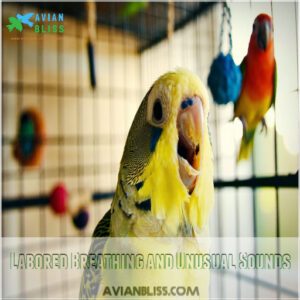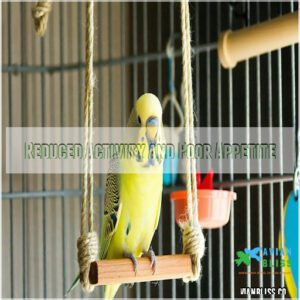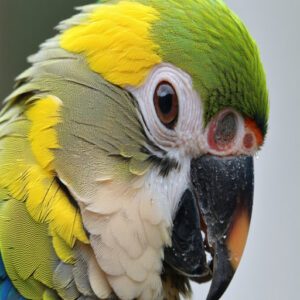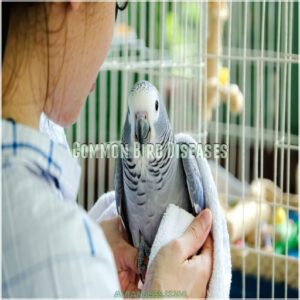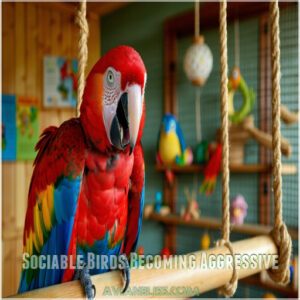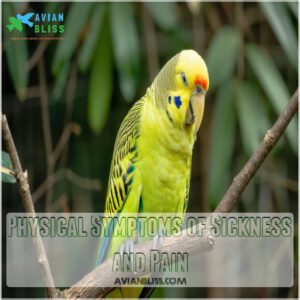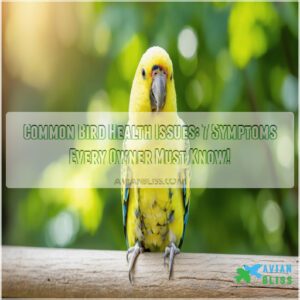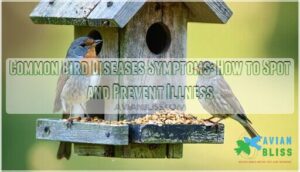This site is supported by our readers. We may earn a commission, at no cost to you, if you purchase through links.
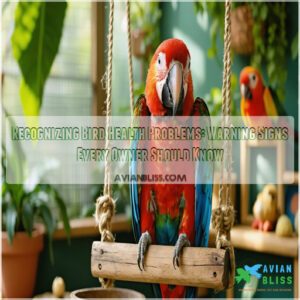
Watch for symptoms like labored breathing, wheezing, or strange noises—these may point to respiratory issues. A bird that’s suddenly tired, eating less, or sleeping more than usual could be sick or stressed.
Check feathers and droppings, too—dull plumage, feather plucking, or soiled vents are red flags, while odd-colored droppings can indicate illness.
Poor diets, like seed-only feeding, lead to vitamin deficiencies that weaken your bird’s overall health. Prevention is key: offer balanced nutrition, maintain clean air and space, and keep an eye out for subtle changes.
Your bird’s health truly rests on your observation skills!
Table Of Contents
- Key Takeaways
- Bird Health Warning Signs
- Common Bird Diseases
- Nutritional Deficiencies Risks
- Recognizing Behavioral Changes
- Diagnostic Signs and Prevention
- Frequently Asked Questions (FAQs)
- Is a sick bird a sign of ill health?
- How do you know if a bird is sick?
- What diseases can birds transmit?
- How do you know if a bird has respiratory problems?
- How can you tell if a bird is a problem?
- What causes ill health in birds?
- How do you know if a bird has a disease?
- How do I know if my bird has a neurological problem?
- What does ataxia look like in birds?
- What is the most common disease in birds?
- Conclusion
Key Takeaways
- Watch for breathing problems like wheezing, open-beak breathing, or tail bobbing—these can signal serious respiratory issues.
- Pay attention to changes in droppings, feather condition, and behavior, like lethargy or poor appetite, as they often point to illness.
- Maintain a clean cage, balanced diet, and regular vet check-ups to prevent common bird diseases and nutritional deficiencies.
- Act fast if you notice symptoms like nasal discharge, fluffed feathers, or changes in activity—early detection is key to recovery.
Bird Health Warning Signs
Spotting the symptoms of illness in your bird early can make all the difference in their recovery and long-term well-being.
From labored breathing to changes in feather condition, recognizing these warning signs helps you take quick, effective steps to maintain their health.
Labored Breathing and Unusual Sounds
If your bird’s breathing sounds off, like wheezing or crackling, it could signal serious respiratory issues.
Watch for labored breathing or open-beak panting, as these may indicate airway obstructions. Sudden breathing changes often stem from poor air quality or infections.
Consider exploring bird wheezing treatment options for potential solutions. Don’t delay—these signs could worsen quickly.
Provide fresh air and consult a vet if symptoms persist.
Reduced Activity and Poor Appetite
Low energy and unusual stillness aren’t just lazy days—they’re fatigue signs that might indicate trouble.
If your bird shows lethargy, appetite loss, or reduced activity, don’t overlook it.
A weak immune system from stress or diet can invite illness.
Sudden bird lethargy combined with loss appetite means a trip to the vet is smart to rule out serious health issues.
Changes in Droppings and Feather Condition
Unusual changes in droppings or feather condition can indicate a sick bird.
Watch for abnormal dropping color, consistency, or frequency, as well as feather loss, plucking, or molting problems.
Dull, broken feathers can indicate underlying health problems, so recognizing these early feather problem signs is essential.
Soiled feathers around the vent may signal vent issues.
These signs often suggest underlying bird disease signs or bird illness symptoms.
Recognizing feather changes early can prevent more serious health concerns.
Discharge From Eyes and Nares
Keep an eye out for nasal discharge or eye infections, as they could signal serious respiratory issues like psittacosis or avian polyomavirus.
Look for:
- Discharge around the beak or eyes.
- Swelling or redness (like conjunctivitis).
- Crustiness on nares or beak lesions.
- Changes in breathing, like labored breathing.
Seek veterinary care promptly to prevent worsening sinus problems.
Sinusitis and Respiratory Infections
If you notice labored breathing, nasal swelling, or discharge, your bird might’ve sinus infections or other respiratory issues like Avian Pneumonia or tracheal problems.
Poor air quality, stress, and infections can weaken the respiratory system, leading to respiratory failure.
Prevent problems by keeping cages clean, ensuring good ventilation, and addressing symptoms quickly with a vet to avoid worsening respiratory infections.
Common Bird Diseases
Caring for a bird means staying alert to common diseases that can seriously impact its health.
Recognizing early symptoms, like breathing issues or abnormal behavior, and taking quick action can often prevent complications.
Psittacosis and Avian Influenza
Psittacosis and avian influenza are serious threats to bird health. Both are highly contagious, with Psittacosis posing zoonotic risks to humans.
Watch for respiratory issues, such as wheezing or discharge. Birds may also show signs of feather fluffing and changes in posture.
Implement strict infection control measures to prevent viral spread.
- Symptoms: Sneezing, nasal discharge, lethargy
- Prevention: Regular cage cleaning, proper ventilation
- Bird Vaccines: Vaccines specific to avian flu
- Health Risks: Respiratory care is important
Polyomavirus and Aspergillosis
Polyomavirus and Aspergillosis are serious avian health problems, affecting young and adult birds differently.
Polyomavirus can lead to tumors and high viral loads, often fatal in juveniles. Aspergillosis is caused by inhaling fungal spores, making breathing difficult.
Psittacosis, a zoonotic respiratory illness, is caused by the Chlamydia psittaci bacteria.
Focus on respiratory care, clean environments, and routine bird vaccines. Early detection and avian therapy are critical to managing these respiratory issues effectively.
| Disease | Cause | Symptoms | Prevention |
|---|---|---|---|
| Polyomavirus | Viral infection | Tumors, lethargy | Vaccination, hygiene |
| Aspergillosis | Moldy food, spores | Difficulty breathing | Clean air, diet |
| Aspergillosis | Spores inhalation | Nasal discharge, wheezing |
Bacterial and Fungal Infections
Bacterial contamination and fungal spores can wreak havoc on your bird’s health, often causing serious respiratory issues like aspergillosis.
Watch for symptoms like open-mouthed breathing or nasal discharge.
Poor hygiene and damp cages are breeding grounds for these infections. Prioritize infection control with proper ventilation and frequent cleaning.
Quick action prevents dangerous conditions like avian mycosis or psittacosis from taking hold.
Parasitic Infections and West Nile Virus
Parasites like mites and lice cause itchy, scaly skin, feather loss, and discomfort.
They’re a top avian health concern. Implement bird parasite control with regular cleaning and monitoring.
Diseases like West Nile and Bird Malaria, spread by mosquitoes, pose serious risks, leading to respiratory issues and weakness.
Protect your bird by eliminating stagnant water and ensuring proper ventilation—small steps, big impact!
House Finch Eye Disease and Avian Pox
House Finch Eye Disease causes eye infections, swelling, and crusty eyelids, often leading to vision problems.
Meanwhile, avian pox appears as wart-like growths on featherless areas, potentially causing skin conditions and feather loss.
Recognizing these signs of illness early is critical. Maintain hygiene, monitor for symptoms, and consider bird vaccines where possible.
Prompt care helps prevent severe bird health problems.
Nutritional Deficiencies Risks
Your bird’s diet plays a critical role in their overall health, and an unbalanced diet can lead to serious nutritional deficiencies.
Watch for symptoms like poor feather quality, reduced energy, or abnormal behavior, and make sure prevention through a varied, nutrient-rich diet.
Malnourishment and Seed-Only Diets
Feeding birds only seeds may seem fine, but it often leads to nutritional deficiencies and severe malnourishment.
Seed diets lack variety, often causing nutrient deficits and dietary imbalances.
Malnourished birds show poor feather quality, lethargy, and vulnerability to disease.
Opt for balanced nutrition, including pellets, fruits, and vegetables, to avoid vitamin shortages.
A diverse diet keeps your bird healthy and thriving.
Vitamin Deficiencies and Mineral Imbalances
A seed-only diet often leads to nutritional deficiencies, weakening your bird’s immune system.
Vitamin A deficiencies can cause breathing trouble, poor feathers, and infections. An Iodine lack might result in a thyroid lump and respiratory issues.
Imbalances in mineral balance harm nutrient absorption.
Consider supplementing your bird’s diet with essential bird vitamin supplements to address potential deficiencies.
Prioritize balanced nutrition with high-quality pellets and fresh vegetables to prevent these vitamin deficiencies and mineral deficiencies.
Calcium and Phosphorus Imbalances
Calcium and phosphorus imbalances can lead to fragile bones, metabolic disorders, and even dangerous conditions like egg binding in female birds.
Watch for bone disease, feather loss, or beak deformity.
Protect your bird with:
- Balanced nutrition including calcium-rich pellets and fresh greens
- Access to sunlight for Vitamin D absorption
- Avoiding diets high in seeds alone
Vitamin a Deficiency and Iodine Deficiency
Vitamin deficiencies, like a Vitamin A deficit or Iodine shortage, can harm your bird’s health, leading to feather lesions, beak deformity, or respiratory issues.
Iodine deficiency in birds can cause goiter, impacting their ability to breathe. These issues stem from poor diets causing nutritional deficiencies and metabolic disorders.
Prevent these with a high-quality pellet diet. For further information, explore this detailed guide on avian iodine deficiency.
| Problem | Symptoms | Prevention |
|---|---|---|
| Vitamin A Deficit | Sneezing, poor appetite | Include leafy greens |
| Iodine Shortage | Breathing difficulty | High-quality pellets |
| Nutrient Imbalance | Weak immune system | Balanced diet |
Importance of Balanced Nutrition
Just like us, birds need a balanced diet to thrive.
A one-sided menu risks nutritional deficiencies, leading to malnourishment risks like weakened immunity or brittle bones.
Stick to a mix of high-quality pellets, fresh veggies, and fruits for proper nutrient balance.
Food variety guarantees they meet their unique dietary needs, keeping them healthy, vibrant, and free from vitamin deficiencies.
Recognizing Behavioral Changes
Recognizing changes in your bird’s behavior is essential because small shifts can signal serious health issues.
Keep an eye out for symptoms like unusual aggression, increased sleep, or a sudden lack of interest in their favorite activities to guarantee early detection.
Sociable Birds Becoming Aggressive
Sudden bird aggression can signal behavioral shifts or avian health concerns.
Watch for Aggression Triggers like social isolation or fear factors in their environment.
Common signs include:
- Beak biting during handling.
- Increased feather plucking or screaming.
- Lunging or snapping unexpectedly.
- Avoiding close contact or interactions.
- Unprovoked defensive behavior.
Address underlying issues like stress, illness, or environmental changes promptly.
Changes in Sleeping Patterns and Appetite
When your bird’s sleep patterns change or they show reduced appetite, it’s more than just quirky behavior—it could mean health trouble.
Look for appetite loss, altered eating habits, or unusual nighttime behavior. Lethargy or stillness during the day may signal illness.
Sudden changes in food intake or lack of energy should prompt a closer look and possibly a vet visit. Monitoring for bird behavior changes is key for early detection of potential health issues in birds.
Increased Sleeping Duration and Disinterest
If your bird sleeps more than usual or seems uninterested in activities, it could signal lethargy signs or bird apathy.
Changes in sleep patterns and social withdrawal often point to emotional stress or an underlying issue like illness.
Watch for unusual stillness or disengagement, as these are common sick bird symptoms.
Recognizing bird behavior changes early prevents serious health risks.
Physical Symptoms of Sickness and Pain
If your bird has puffed feathers, struggles with labored breathing, or shows tail bobbing, they could be unwell.
Look for other physical signs of illness, such as trembling, weight loss, or changes in posture.
Neurological disorders may cause convulsions.
These bird health indicators shouldn’t be ignored.
Spotting these sick bird symptoms early can make a huge difference.
Monitoring for Stress and Anxiety
If your bird seems on edge, it’s time to watch for stress signs and anxiety triggers.
Look for changes like feather plucking, beak problems, or sudden social isolation. Stress can quietly creep up but has drastic effects if unchecked.
- Stress signs: feather loss, pacing, loud vocalizations
- Anxiety triggers: loud noises, sudden environment changes
- Prevention: consistent routine, calm environment
Diagnostic Signs and Prevention
Catching early symptoms and taking proactive steps are critical to keeping your bird healthy.
Focus on prevention with annual check-ups, a clean environment, and a balanced diet to reduce the risk of serious illnesses.
Annual Veterinary Check-Ups and Clean Environment
Regular veterinary checkups guarantee minor issues don’t become major headaches. Combine this with a clean environment to keep your bird happy and healthy.
Finding effective bird cage cleaner products is essential for maintaining a hygienic environment. Dust, droppings, or mold invite sickness. Think hygiene!
| Factor | Why It Matters | Action |
|---|---|---|
| Veterinary Care | Detect hidden problems early | Schedule annual vet appointments |
| Clean Housing | Reduces disease risks | Clean cage weekly |
| Environmental Factors | Prevent respiratory issues | Monitor air quality and humidity |
Balanced Diet and Exercise for Birds
A balanced diet and regular exercise are key to keeping your bird healthy and active.
Poor bird nutrition can lead to nutritional deficiencies and diseases.
Focus on variety: 1. Pellet diets for nutrient absorption, 2. Fresh fruits and vegetables for vitamins, and 3. Exercise routines to prevent bird obesity.
A healthy bird stays vibrant and engaged!
Preventative Measures and Vaccination
Vaccination and preventative care go hand in hand for bird disease prevention.
Protect your bird from serious illnesses by discussing vaccine types during an avian health consultation. Alongside vaccinations, schedule regular bird health checkups for early detection.
For further information on avian influenza, consult this guide on avian influenza medication and prevention.
Combine nutrition planning with medical interventions to strengthen immunity. Prevent outbreaks by ensuring a clean environment, proper hygiene, and a healthy diet.
Monitoring for Signs of Illness and Disease
Spotting signs of illness early can save your bird’s life.
Stay mindful of shifts in behavior or appearance that indicate avian health issues.
- Labored breathing or wheezing suggest respiratory issues.
- Fluffed feathers for hours signal discomfort.
- Dull eyes or unusual discharge hint at infection.
- Appetite loss or lethargy are red flags.
- Unchanged droppings reveal internal trouble.
Act fast—emergency care matters!
Importance of Good Hygiene and Quarantine
Keeping up with hygiene protocols is essential for bird health.
Clean cages, feeders, and water dishes regularly to avoid infections.
Implement quarantine methods for new arrivals to prevent illnesses from spreading.
Sanitation practices reduce disease risks, while biosecurity measures like isolating sick birds are essential.
Consult avian veterinary medicine experts frequently to make sure effective bird vet care and disease prevention strategies are in place.
Frequently Asked Questions (FAQs)
Is a sick bird a sign of ill health?
A sick bird is like a blinking warning light—it signals ill health.
Look for symptoms like lethargy, feather issues, or breathing changes.
Prompt veterinary care and preventive measures, like clean environments, can save their life.
How do you know if a bird is sick?
You’ll notice signs like fluffed feathers, lethargy, or labored breathing.
Watch for changes in eating, droppings, or behavior.
Birds often hide illness, so act quickly if you spot nasal discharge, drooping posture, or unusual quietness.
What diseases can birds transmit?
Did you know birds can pass on diseases like Psittacosis, avian influenza, and salmonellosis?
These illnesses spread through contact, droppings, or dander.
Protect yourself with hygiene habits, clean environments, and regular veterinary care for your bird.
How do you know if a bird has respiratory problems?
You’ll spot respiratory problems in a bird if it shows labored breathing, open-mouthed breathing, or emits unusual clicking or wheezing sounds.
Watch for nasal discharge, sneezing, or tail bobbing—signs that demand immediate veterinary attention.
How can you tell if a bird is a problem?
You’ll notice a bird might’ve a problem when it shows unusual behaviors like lethargy, changes in appetite, or breathing issues.
Watch for symptoms like discharge, fluffed feathers, or persistent quietness.
Consult a vet promptly.
What causes ill health in birds?
Poor nutrition, polluted environments, and pesky parasites often plague birds’ health.
Respiratory issues, nutritional deficiencies, and infectious diseases escalate with stress, dirty cages, or weak immune systems.
Prioritize fresh food, clean spaces, and regular vet check-ups.
How do you know if a bird has a disease?
Watch for labored breathing, fluffed feathers, or a bird sitting low on its perch.
Decreased activity, appetite changes, unusual droppings, or discharge around eyes and nostrils often point to disease—act quickly by consulting a vet.
How do I know if my bird has a neurological problem?
Nearly 10% of pet bird illnesses have a neurological link.
Look for trembling, seizures, or difficulty moving.
Exposure to toxins, infections, or metabolic imbalances might be to blame, so a vet visit is essential.
What does ataxia look like in birds?
Ataxia in birds looks like unsteady movements, trouble perching, or falling over.
You might notice head tilting, wobbling, or difficulty flying.
It’s often a sign of neurological issues, so don’t wait—contact a vet.
What is the most common disease in birds?
The most common disease in birds is Psittacosis, also known as "Parrot Fever."
It spreads easily between birds and humans, with symptoms like breathing difficulties and discharge.
Prevention includes clean environments, balanced diets, and regular vet check-ups.
Conclusion
Your bird’s health is like a puzzle, and recognizing bird health problems means spotting the missing pieces early.
Watch for symptoms like changes in breathing, appetite, or droppings. Small shifts, such as dull feathers or unusual behaviors, often hint at bigger issues.
By offering a balanced diet, maintaining cleanliness, and scheduling vet check-ups, you’ll keep your bird thriving. Be observant, proactive, and loving—your sharp eye and care can make all the difference in their well-being.
- https://www.petcircle.com.au/discover/common-bird-illnesses
- https://www.thesprucepets.com/common-diseases-in-pet-birds-390443
- https://www.merckvetmanual.com/bird-owners/routine-care-and-breeding-of-birds/signs-of-illness-in-pet-birds
- https://vcahospitals.com/know-your-pet/recognizing-the-signs-of-illness-in-pet-birds
- https://www.mit.edu/~rei/Birds-sick.html

